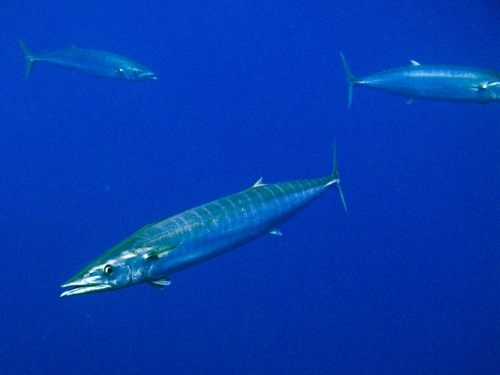
Wahoo
The Atlantic Bluefin Tuna (Thunnus thynnus) is a highly migratory, large pelagic fish renowned for its size, speed, and commercial value. It is one of the most impressive and economically significant fish in the ocean. This species plays a crucial role in the marine ecosystem and is a top predator. Its unique physiology, behavior, and life cycle make it a subject of fascination and concern, especially given its current conservation status.
5 9 years
Lifespan
250 cm
Length
Least Concern
Conservation Status
77 km/h
Swimming speed
Carnivorous
Diet
Highly Migratory, Seasonal Migration
Migration
Appearance Overview
The Atlantic Bluefin Tuna showcases a torpedo-shaped body, built for speed and endurance in the water.
Color
Dark metallic blue on top, with a silvery-white underside
Fins
Two dorsal fins; the second is taller than the first
Body shape
Torpedo-like streamlined body for efficient swimming
Skin
Smooth skin with small scales
Length
Up to 13 feet (4 meters)
Weight
Up to 2,000 lbs (907 kg)
Diet
Carnivorous, feeding on a variety of fish, squid, eels, and crustaceans.
Feeding Behavior
Highly active predators, they use their speed to chase down prey. They are also known to cooperate in groups to herd and capture prey.
Social Behavior
Known to form schools, especially during migrations. These schools can sometimes include thousands of individuals, and are often segregated by the size of the fish.
Commercial Relevance
Extremely high value, especially in sushi and sashimi markets, where a single fish can be sold for thousands or even millions of dollars.
Conservation measures
Measures include international fishing quotas, size limits, and seasonal closures. Efforts are also focused on reducing bycatch and improving fishing gear selectivity.
Status
Endangered
Threats
Primarily threatened by overfishing due to high demand in the seafood market. Other threats include habitat degradation and climate change affecting their prey and spawning areas.
Habitat Distribution
Depth Range
0-1,000 meters, but they are often found in surface waters.
Geographic Range
Atlantic Ocean, including the Mediterranean Sea and the Gulf of Mexico.
Preferred Environment
Primarily pelagic, inhabiting both cold temperate and warm tropical waters.
Reproduction and Life Cycle
Breeding Habits
Spawns in two main areas: the Mediterranean Sea and the Gulf of Mexico. Spawning typically occurs in warmer waters during spring and summer.
Development Stages
Eggs hatch into larvae, which rapidly develop into juveniles. Growth continues at a fast pace, with the fish reaching significant size within the first few years.
Fecundity
Highly fecund; a single female can produce up to 30 million eggs per spawning season.
Maturity Age
Reaches sexual maturity relatively late, typically between 4-8 years of age.
Faqs about Wahoo
How long do Atlantic Bluefin Tuna live?
Atlantic Bluefin Tuna can live up to 40 years.
Where can Atlantic Bluefin Tuna be found?
They are primarily found in the Atlantic Ocean, ranging from the cold waters of the North Atlantic to the warmer tropical waters of the Gulf of Mexico and the Mediterranean Sea.
What are the natural predators of the Atlantic Bluefin Tuna?
They have few natural predators as adults, mainly large sharks and orcas.
Do Atlantic Bluefin Tuna migrate?
Yes, they undertake long migrations across the Atlantic Ocean for feeding and spawning.
Are Atlantic Bluefin Tuna warm-blooded?
They are warm-blooded, which allows them to maintain a body temperature higher than the surrounding water, aiding in their speed and endurance.
Copyright @ Nature Style Limited. All Rights Reserved.
 English
English